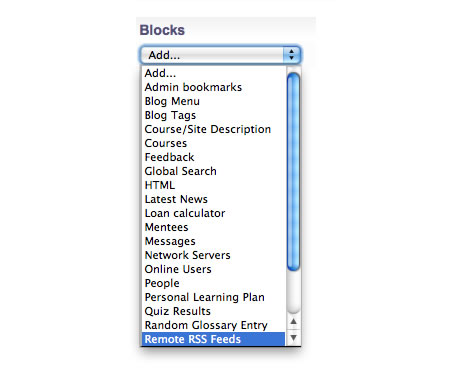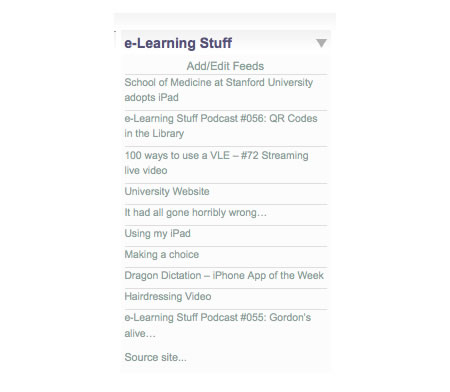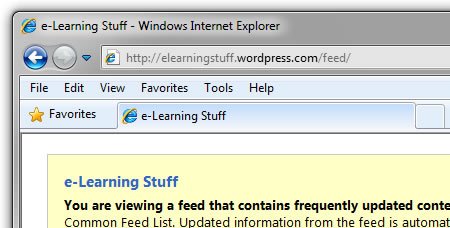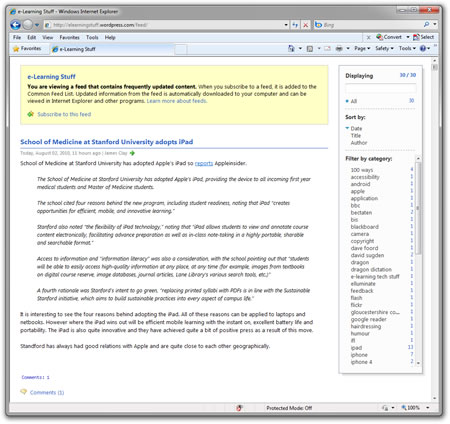Keeping the content on the VLE current, topical and updated can be a real challenge for many practitioners. It can be both time consuming and if you are new to adding regular additional content to the VLE it can be easily forgotten that you said to yourself that you would regularly add content.
Of course for virtually all subjects there are loads of other people out there creating new, current and topical content. On blogs and news sites, lots of relevant and interesting content is being created.
The key is to ensure that the learners are made aware of that content quickly and easily.
You can of course copy and paste links and content into the VLE, but this has to be done manually and sometimes you are busy or just plain forget…
So that’s where RSS comes in.
What’s RSS?
Really Simple Syndication!
What’s Really Simple Syndication?
I knew you might ask me that!
The simple explanation is that RSS allows for content to be easily used and shared (syndicated) onto other web sites automatically. As that content is updated, the RSS ensures that the updated content is made available on the other web sites.
When content sites (like the BBC) update their content, they update their RSS feed. This feed can then be “added” to the VLE ensuring that when the content (and the RSS feed) is updated, the content on the VLE is automatically updated.
So by adding RSS feeds into the VLE, you can easily add new and exciting content into the VLE that update automatically without either the practitioners or learners needing to do anything.
I should point out that a few learners may want to subscribe to the RSS feed direct using a browser or feed reader. They may for example have a feed reader on their iPad or other mobile device.
So how do you add an RSS Feed into the VLE?
Well different VLEs do it in different ways. On Moodle the easiest way is via the Remote RSS Feeds Block.

This then allows you to add an RSS feed (like the feed from this blog) into the VLE.

The next question is I know, how do you know where the RSS feed is?
Well the address for the feeds will look something like this.
http://feeds.bbci.co.uk/news/technology/rss.xml
https://elearningstuff.net/feed/
http://screenr.com/user/jamesclay/rss
http://audioboo.fm/users/2631/boos.atom
As you can see it’s not just news and blogs that have RSS feeds, you can also find RSS feeds for services like Screenr, Flickr and Audioboo.
So when you visit a page with an RSS feed on most modern browsers they will have an RSS icon.

Click the RSS icon to see the feed. Another way of describing an RSS feed is as content without the formatting.
In this example the feed is in the address bar.

Copy that into the Add a news feed URL field on the VLE.

This will allow you to embed the RSS feed into the VLE.
What’s nice about the Moodle Embed RSS block is that you can add multiple feeds into a single block.
Adding an RSS feed to the VLE can be for many practitioners quite a complex and challenging task, mainly as it can be difficult for many of them to understand what RSS is and means. However once you get past that hurdle it is then a quick and easy way to add current and topical content to your course on the VLE automatically.
Photo source.



Have you been able to get the images in a Flickr feed to show up? All I get is the link to the image; I’ve checked with the same feed in other RSS readers (works fine) – have tried fiddling with assorted options in Moodle (2.2) – I can get my avatar from Flickr, but that’s as close as I get to the images!
Just did a quick test and I could get the images to appear. I used this RSS feed for the Moodle Block for my Flickr feed, http://api.flickr.com/services/feeds/photos_public.gne?id=7888746@N08&lang=en-us&format=rss_200
Sorted! I’d forgotten to click the ‘show each link’s description’ on the page when you’re adding the block; I’d been trying to find something to click on the page where you’re setting up the feed.